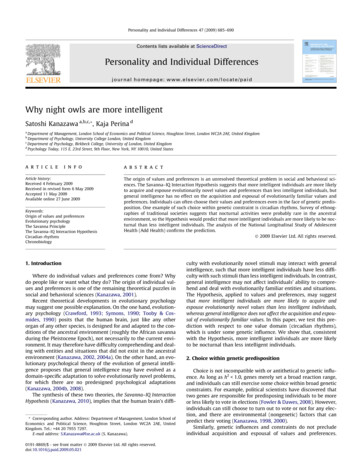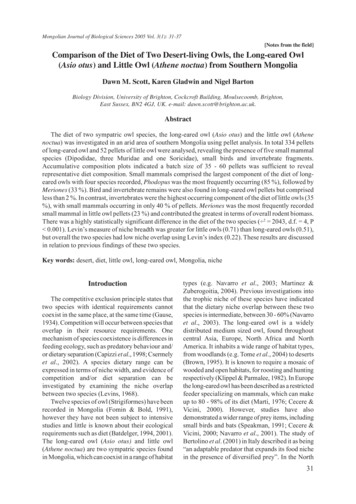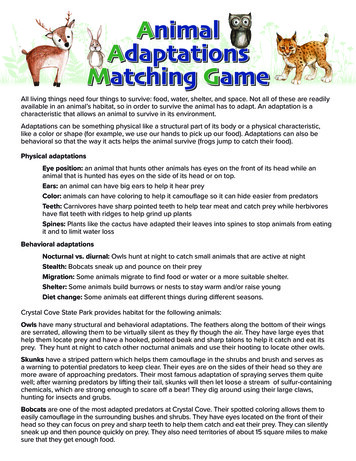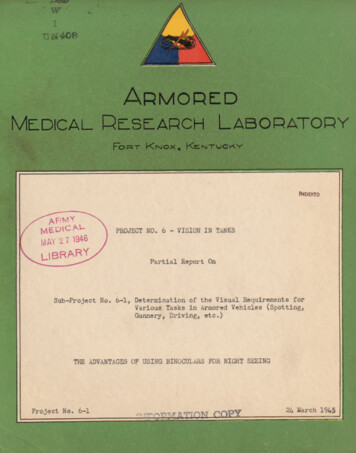
Transcription
Personality and Individual Differences 47 (2009) 685–690Contents lists available at ScienceDirectPersonality and Individual Differencesjournal homepage: www.elsevier.com/locate/paidWhy night owls are more intelligentSatoshi Kanazawa a,b,c,*, Kaja Perina daDepartment of Management, London School of Economics and Political Science, Houghton Street, London WC2A 2AE, United KingdomDepartment of Psychology, University College London, United KingdomDepartment of Psychology, Birkbeck College, University of London, United KingdomdPsychology Today, 115 E. 23rd Street, 9th Floor, New York, NY 10010, United Statesbca r t i c l ei n f oArticle history:Received 4 February 2009Received in revised form 6 May 2009Accepted 11 May 2009Available online 27 June 2009Keywords:Origin of values and preferencesEvolutionary psychologyThe Savanna PrincipleThe Savanna–IQ Interaction HypothesisCircadian rhythmsChronobiologya b s t r a c tThe origin of values and preferences is an unresolved theoretical problem in social and behavioral sciences. The Savanna–IQ Interaction Hypothesis suggests that more intelligent individuals are more likelyto acquire and espouse evolutionarily novel values and preferences than less intelligent individuals, butgeneral intelligence has no effect on the acquisition and espousal of evolutionarily familiar values andpreferences. Individuals can often choose their values and preferences even in the face of genetic predisposition. One example of such choice within genetic constraint is circadian rhythms. Survey of ethnographies of traditional societies suggests that nocturnal activities were probably rare in the ancestralenvironment, so the Hypothesis would predict that more intelligent individuals are more likely to be nocturnal than less intelligent individuals. The analysis of the National Longitudinal Study of AdolescentHealth (Add Health) confirms the prediction.Ó 2009 Elsevier Ltd. All rights reserved.1. IntroductionWhere do individual values and preferences come from? Whydo people like or want what they do? The origin of individual values and preferences is one of the remaining theoretical puzzles insocial and behavioral sciences (Kanazawa, 2001).Recent theoretical developments in evolutionary psychologymay suggest one possible explanation. On the one hand, evolutionary psychology (Crawford, 1993; Symons, 1990; Tooby & Cosmides, 1990) posits that the human brain, just like any otherorgan of any other species, is designed for and adapted to the conditions of the ancestral environment (roughly the African savannaduring the Pleistocene Epoch), not necessarily to the current environment. It may therefore have difficulty comprehending and dealing with entities and situations that did not exist in the ancestralenvironment (Kanazawa, 2002, 2004a). On the other hand, an evolutionary psychological theory of the evolution of general intelligence proposes that general intelligence may have evolved as adomain-specific adaptation to solve evolutionarily novel problems,for which there are no predesigned psychological adaptations(Kanazawa, 2004b, 2008).The synthesis of these two theories, the Savanna–IQ InteractionHypothesis (Kanazawa, 2010), implies that the human brain’s diffi-* Corresponding author. Address: Department of Management, London School ofEconomics and Political Science, Houghton Street, London WC2A 2AE, UnitedKingdom. Tel.: 44 20 7955 7297.E-mail address: S.Kanazawa@lse.ac.uk (S. Kanazawa).0191-8869/ - see front matter Ó 2009 Elsevier Ltd. All rights reserved.doi:10.1016/j.paid.2009.05.021culty with evolutionarily novel stimuli may interact with generalintelligence, such that more intelligent individuals have less difficulty with such stimuli than less intelligent individuals. In contrast,general intelligence may not affect individuals’ ability to comprehend and deal with evolutionarily familiar entities and situations.The Hypothesis, applied to values and preferences, may suggestthat more intelligent individuals are more likely to acquire andespouse evolutionarily novel values than less intelligent individuals,whereas general intelligence does not affect the acquisition and espousal of evolutionarily familiar values. In this paper, we test this prediction with respect to one value domain (circadian rhythms),which is under some genetic influence. We show that, consistentwith the Hypothesis, more intelligent individuals are more likelyto be nocturnal than less intelligent individuals.2. Choice within genetic predispositionChoice is not incompatible with or antithetical to genetic influence. As long as h2 1.0, genes merely set a broad reaction range,and individuals can still exercise some choice within broad geneticconstraints. For example, political scientists have discovered thattwo genes are responsible for predisposing individuals to be moreor less likely to vote in elections (Fowler & Dawes, 2008). However,individuals can still choose to turn out to vote or not for any election, and there are environmental (nongenetic) factors that canpredict their voting (Kanazawa, 1998, 2000).Similarly, genetic influences and constraints do not precludeindividual acquisition and espousal of values and preferences.
686S. Kanazawa, K. Perina / Personality and Individual Differences 47 (2009) 685–690Individuals can still choose certain values and preferences evenin the face of genetic predisposition. For example, both politicalideology (Alford, Funk, & Hibbing, 2005) and religiosity (Bouchard, McGue, Lykken, & Tellegen, 1999; Koenig, McGue, Krueger, & Bouchard, 2005) have now been shown to have geneticbases; some individuals are genetically predisposed to be liberalor conservative, or more or less religious. Yet more intelligentchildren are more likely to grow up to be liberal and less likelyto grow up to be religious (Kanazawa, 2010). In this paper, wefocus on one example of such choice within genetic constraints:whether one is a morning person or a night person (circadiantypology).3. Circadian typology (morningness–eveningness)Virtually all species in nature, from single-cell organisms tomammals, including humans, exhibit a daily cycle of activity calledthe circadian rhythm. ‘‘This timekeeping system, or biological‘‘clock,” allows the organism to anticipate and prepare for thechanges in the physical environment that are associated with dayand night, thereby ensuring that the organism will ‘‘do the rightthing” at the right time of the day” (Vitaterna, Takahashi, & Turek,2001, p. 85). The circadian rhythm in mammals is regulated by twoclusters of nerve cells called the suprachiasmatic nuclei (SCN) inthe anterior hypothalamus (Klein, Moore, & Reppert, 1991). Geneticists have by now identified a set of genes that regulate the SCNand thus the circadian rhythm among mammals (King & Takahashi,2000). A behavior genetic study of South Korean twins (n 977pairs) shows that heritability in morningness–eveningness is .45and nonshared environment accounts for 55% of the variance,while shared environment does not appear to explain any of thevariance in it (Hur, 2007).‘‘For most animals, the timing of sleep and wakefulness undernatural conditions is in synchrony with the circadian control ofthe sleep cycle and all other circadian-controlled rhythms. Humans,however, have the unique ability to cognitively override their internalbiological clock and its rhythmic outputs” (Vitaterna et al., 2001, p.90; emphasis added). While there are some individual differencesin the circadian rhythm, where some individuals are more nocturnal than others, humans are basically a diurnal (as opposed to nocturnal) species. Humans rely very heavily on vision for navigationbut, unlike genuinely nocturnal species, cannot see in the dark orunder little lighting, and our ancestors did not have artificial lighting during the night until the domestication of fire. Any human inthe ancestral environment up and about during the night wouldhave been at risk of predation by nocturnal predators. It is therefore safe to assume that our ancestors rose at around dawn andwent to sleep at around dusk, to take full advantage of the naturallight provided by the sun, and the ‘‘night life” (sustained and organized activities at night after dusk) is probably evolutionarilynovel.In order to ascertain the extent to which our ancestors mighthave engaged in nocturnal activities, we have consulted ethnographic records of traditional societies throughout the world. Inthe 10-volume compendium The Encyclopedia of World Cultures(Levinson, 1991–1995), which extensively describes all human cultures known to anthropology, there is no mention of nocturnalactivities in any of the traditional cultures. There are no entriesin the index for ‘‘nocturnal,” ‘‘night,” ‘‘evening,” ‘‘dark(ness),” and‘‘all-night.” The few references to the ‘‘moon” are all religious, asin ‘‘moon deity,” ‘‘Mother Moon (deity),” and ‘‘moon worship.”The only exception is the ‘‘night courting,” which is a socially approved custom of premarital sex observed among the Danes andthe Finns, which are entirely western cultures far outside of theancestral environment.In addition, we have consulted the following extensive (monograph-length) ethnographies of traditional societies around theworld: Yanomamö (Chagnon, 1992); From Mukogodo to Maasai: Ethnicity and Cultural Change in Kenya (Cronk, 2004); Ache Life History:The Ecology and Demography of a Foraging People (Hill & Hurtado,1996); The !Kung San: Men, Women, and Work in a Foraging Society(Lee, 1979); and Sacha Runa: Ethnicity and Adaptation of EcuadorianJungle Quichua (Whitten, 1976). Many of these ethnographies contain a section where the authors describe what usually happensand what people routinely do in a typical day in the tribal societyunder study.These detailed ethnographic records make it clear that the dayfor people in these traditional societies begins shortly before sunrise, and ends shortly after sun set. ‘‘Daily activities begin earlyin a Yanomamö village” (Chagnon, 1992, p. 129). ‘‘The day beginsabout 6 a.m., when the sun is about to rise” (Cronk, 2004, p. 88).The only routine activities conducted after dark are people conversing and visiting with each other as they drift off to sleep. ‘‘Despite the inevitable last-minute visiting, things are usually quiet inthe village by the time it is dark” (Chagnon, 1992, p. 132). ‘‘Mostevenings are spent quietly chatting with family members indoors.If the moon is full then it is possible to see almost as well as duringthe day, and people take advantage of the light by staying up lateand socializing a great deal” (Cronk, 2004, p. 93). ‘‘After cookingand consuming food, evening is often the time of singing and joking. Eventually band members drift off to sleep, with one or twonuclear families around each fire” (Hill & Hurtado, 1996, p. 65).The only nocturnal activities, other than chatting, visiting, andmaking speeches, that we can find in all of these ethnographiesis when Mukogodo men go searching for missing animals in thedark, if one happens to be missing (Cronk, 2004, p. 92).Ethnographic evidence of traditional societies therefore suggests that our ancestors probably had a largely diurnal lifestyle,and sustained and routine nocturnal activities may be evolutionarily novel. The Savanna–IQ Interaction Hypothesis would therefore predict that more intelligent individuals are more likely tobe nocturnal, getting up later in the morning and going to bed laterin the evening, than less intelligent individuals. To our knowledge,there is only one study which examines the association betweenintelligence and circadian rhythm. Roberts and Kyllonen (1999)find that, in a small sample of United States Air Force recruits(n 420), evening types are significantly more intelligent thanmorning types. We seek to replicate their findings in a large,nationally representative sample of Americans.4. Empirical analysis4.1. Method4.1.1. Data: National Longitudinal Study of Adolescent Health (AddHealth)A sample of 80 high schools and 52 middle schools from the USwas selected with unequal probability of selection. Incorporatingsystematic sampling methods and implicit stratification into theAdd Health study design ensures this sample is representative ofUS schools with respect to region of country, school size, schooltype, and ethnicity. A sample of 20,745 adolescents were personally interviewed in their homes in 1994–1995 (Wave I), and againin 1996 (Wave II; n 14,738). In 2001–2002, 15,197 of the originalWave I respondents, now age 18–28, were interviewed in theirhomes. Our sample consists of Wave III respondents.4.1.2. Dependent variable: nocturnalityAdd Health asks its respondents about their sleeping habitswith four different questions in Wave III. ‘‘On days when you go
S. Kanazawa, K. Perina / Personality and Individual Differences 47 (2009) 685–690to work, school, or similar activities, what time do you usuallywake up?” ‘‘What time do you usually go to sleep the night (orday) before?” ‘‘On days you don’t have to get up at a certain time,what time do you usually get up?” ‘‘On those days, what time doyou usually go to sleep the night or day before?” We call the firsttype of days ‘‘weekdays” and the latter type of days ‘‘weekend.”For each question, the respondent indicates the time by firstmarking the hour (from 1:00 to 12:00), then the minute (from 00to 59), and finally indicating whether the hour is AM or PM. Thedistributions of indicated bedtimes show that a large number ofrespondents (n 3,073, 20.2% for weeknights, and n 2,971,19.5% for weekends) claim to go to bed at 12:00PM (noon) and12:30PM (half an hour after noon), when very few people claimto go to bed during the 11:00 h or the 13:00 h. We assume this isa result of the confusion of 12:00AM (midnight) and 12:00PM(noon). We have therefore changed all 12:00 h bedtime to00:00 h bedtime. The reassignment of these cases does not affectour substantive conclusion at all; in fact, the predicted effect ofintelligence on nocturnality is slightly stronger if we delete all ofthese cases rather than reassign them.4.1.3. Independent variable: childhood IQAdd Health measures respondents’ intelligence with the Peabody Picture Vocabulary Test (PPVT). The raw scores (0–87) areage-standardized and converted to the IQ metric, with a mean of100 and a standard deviation of 15. The PPVT is a valid measureof verbal intelligence, not general intelligence. However, verbalintelligence is known to be highly correlated with (and thus heavily loads on) general intelligence. Miner’s (1957) extensive reviewof 36 studies shows that the median correlation between vocabulary and general intelligence is .83. Wolfle (1980) reports that thecorrelation between a full-scale IQ test (Army General Classification Test) and the General Social Surveys synonyms measure is.71. As a result, the GSS synonyms measure has been used widelyby intelligence researchers to assess trends in general intelligence(Huang & Hauser, 1998). In order to establish the direction of causality more clearly, we will use the measure of intelligence taken inWave I (in 1994–1995 when the respondents were in junior highand high school) to predict their adult nocturnality in Wave III(in 2001–2002 when the respondents were in their earlyadulthood).Control variables. We control for the following variables: age(even though there is very little variance in it given that theseare cohort data); sex (0 if female, 1 if male); race (with three dummies for Asian, black, and Native American, with white as the reference category); marital status (1 if currently married); parentalstatus (1 if parent); education (years of formal schooling); earnings(in dollars); and religion (with four dummies for Catholic, Protestant, Jewish, and other, with none as the reference category).Further, because previous studies show that students are morelikely to be nocturnal than comparable individuals in full-timeemployment (Mecacci & Zani, 1983), we control for whether ornot the respondent is a student (1 if currently in school). In addition, because demands of work can affect one’s sleeping patterns,we control for how many hours the respondent typically worksin a week.5. ResultsFig. 1 presents bivariate associations between childhood IQ andchronobiology. We divide the Add Health sample into five ‘‘cognitive classes” (Herrnstein & Murray, 1994) by childhood IQ: ‘‘Verydull” (IQ 75); ‘‘Dull” (75 IQ 90); ‘‘Normal” (90 IQ 110);‘‘Bright” (110 IQ 125); and ‘‘Very bright” (IQ 125). Fig. 1, Panel(a), shows that there is a monotonic association between cognitive687class and the time Add Health respondents go to bed on weeknights. ‘‘Very dull” individuals (n 584) on average go to bed at23:41; ‘‘dull” individuals (n 2,967) go to bed at 00:03; ‘‘normal”individuals (n 6,820) go to bed at 00:10; ‘‘bright” individuals(n 3,483) go to bed at 00:21; and ‘‘very bright” individuals (n 468) go to bed at 00:29. The absolute differences inminutes are small, but all the differences between two adjacentcategories are statistically significant, except for ‘‘bright” and ‘‘verybright.”Fig. 1, Panel (b), similarly shows that, while individuals of allcognitive classes go to bed roughly one hour later on weekendsthan they do on weeknights, there is still a monotonic associationbetween cognitive class and the time Add Health respondents go tobed on weekends. ‘‘Very dull” individuals (n 585) on average goto bed at 00:35; ‘‘dull” individuals (n 2,985) go to bed at 01:03;‘‘normal” individuals (n 6,854) go to bed at 01:13; ‘‘bright” individuals (n 3,488) go to bed at 01:25; and ‘‘very bright” individuals (n 465) go to bed at 01:44. All the differences between twoadjacent categories are statistically significant.Fig. 1, Panel (c), shows that there is a monotonic association between cognitive class and what time Add Health respondents wakeup on weekday morning. ‘‘Very dull” individuals (n 583) on average wake up at 07:20; ‘‘dull” individuals (n 2,965) wake up at07:25; ‘‘normal” individuals (n 6,814) wake up at 07:32; ‘‘bright”individuals (n 3,480) wake up at 07:40; and ‘‘very bright” individuals (n 468) wake up at 07:52. All the differences between twoadjacent categories are statistically significant, except for ‘‘verydull” and ‘‘dull.”Finally, Fig. 1, Panel (d), shows that, while individuals of all cognitive classes wake up roughly three hours later on weekends thanthey do on weekdays, there is still a monotonic association between cognitive class and what time Add Health respondents wakeup on weekend morning. ‘‘Very dull” individuals (n 586) on average wake up at 10:09; both ‘‘dull” individuals (n 2,986) and ‘‘normal” individuals (n 6,850) wake up at 10:14; ‘‘bright” individuals(n 3,488) wake up at 10:23; and ‘‘very bright” individuals(n 466) wake up at 11:07. Only the differences between ‘‘normal”and ‘‘bright” and between ‘‘bright” and ‘‘very bright” are statistically significant.Table 1 presents the results of OLS regression analyses of AddHealth respondents’ circadian rhythms. (The dependent variablehere is converted from the normal base-60 sexagesimal time tothe base-10 decimal time.) The first column shows that, net ofage, sex, race, marital status, parental status, education, earnings,religion, student status and number of hours worked, childhoodIQ significantly delays the time that Add Health respondents usually go to bed on weeknight. Older respondents (even in this limited age range) go to bed earlier than younger respondents, andmen go to bed later than women. Consistent with expectations,married individuals and parents go to bed earlier. Christians (Catholics and Protestants) go to bed earlier, and, consistent with a previous finding (Mecacci & Zani, 1983), current students go to bedlater than nonstudents. As expected, individuals who work morehours go to bed earlier.Table 1, second column, shows that, net of the same controlvariables, childhood IQ significantly delays the time that AddHealth respondents usually go to bed on weekends. Most of theother variables in the equation have the same effect on weekendbedtime as they do on weeknight bedtime, with the exception thatblacks go to bed significantly later than whites on weekends butnot on weeknights. Marital and parental statuses have much greater negative effect on weekend bedtime than weeknight bedtime.Table 1, third column, shows that, net of the same control variables, childhood IQ significantly delays the time that Add Healthrespondents usually wake up on weekdays. Most of the other variables in the equation have the same effect on what time they wake
688S. Kanazawa, K. Perina / Personality and Individual Differences 47 (2009) 685–690Fig. 1. Bivariate association between childhood IQ and chronobiology. Note: Error bars represent the standard error for the mean.up on weekdays as they do on what time they go to bed onweeknights, with the exception that more educated people wakeup earlier on weekdays. While individuals who work longer hoursgo to bed earlier and wake up earlier on weekdays, students go tobed later and wake up earlier. Table 1, fourth column, shows that,while the effect of childhood IQ on what time Add Health respondents wake up on weekend is once again positive, its effect doesnot reach statistical significance (p .18). Most of the other variables have the same effects as before.An anonymous reviewer suggests that the Savanna–IQ Interaction Hypothesis may also imply that more intelligent individualshave a greater variance in their chronobiology than less intelligentindividuals. It does not appear to be the case, however, with theAdd Health data. The test of homogeneity of variances shows thatvariances are heterogeneous by childhood cognitive class in weekday time to go to bed (Levene statistic 14.590, df 4, 14317,p .001), weekend time to go to bed (Levene 15.295, df 4,14372, p .001), and weekday time to wake up (Levene 3.182,df 4, 14305, p .05), but not in weekend time to wake up (Levene 2.084, df 4, 14371, p .05). However, for weekday andweekend time to go to bed, variance decreases with childhoodintelligence; for weekday time to wake up, it has an inverted Ushaped distribution, with the greatest variance among the ‘‘normal” childhood IQ category.Taken together, results presented in Table 1 largely support ourhypothesis that more intelligent individuals are more likely to benight owls. The effect of childhood IQ on three out of four measuresof nocturnality is significantly positive, even net of a large numberof demographic and biological variables expected to affect circadian rhythms. However, we should point out that, while the effectsof childhood IQ are highly statistically significant due to the largesample size, both the effect size (measured by the standardizedregression coefficient) and the proportion of explained variance(R2) are very small.
689S. Kanazawa, K. Perina / Personality and Individual Differences 47 (2009) 685–690Table 1The effect of childhood IQ on adult circadian typology (measured in hours) Add Health.Time to go to bedChildhood IQAgeSex(0 female, 1 male)RaceAsianBlackNative AmericanMarital status (1 if currently married)Parental status (1 if JewishOtherCurrently in school (1 if currently in school)Hours workedConstantR2Number of casesTime to wake Note: Main entries are unstandardized regression coefficients. (Entries in parentheses are standard errors.). Entries in italics are standardized regression coefficients.p .05.p .01.***p .001.****p .0001 (two-tailed).***6. ConclusionThe Savanna–IQ Interaction Hypothesis suggests that moreintelligent individuals may be more likely to acquire and espouseevolutionarily novel values and preferences than less intelligentindividuals, while general intelligence may have no effect on theacquisition and espousal of evolutionarily familiar values andpreferences. An earlier study (Kanazawa, 2010) has shown thatmore intelligent individuals are more likely to be liberal and atheist, and more intelligent men (but not women) are more likely tovalue sexual exclusivity, than their less intelligent counterparts. Inthis paper, we have extended the Hypothesis to circadianrhythms.While studies show that there is some genetic component toindividuals’ circadian rhythms (Hur, 2007), heritability of thesephenotypes is far from 1.0 and thus there is room for individualchoices and decisions. Survey of ethnographies of traditional societies shows that routine nocturnal activities were probably rare inthe ancestral environment and are thus evolutionarily novel. TheSavanna–IQ Interaction Hypothesis therefore predicts that moreintelligent individuals are more likely to be nocturnal than lessintelligent individuals.
690S. Kanazawa, K. Perina / Personality and Individual Differences 47 (2009) 685–690Our analysis of Add Health data supports the prediction derivedfrom the Hypothesis. Net of age, sex, race, marital status, parentalstatus, education, earnings, religion, whether one is currently a student and the number of hours worked per week, childhood IQ significantly increases nocturnal behavior in early adulthood. Moreintelligent children are more likely to grow up to be nocturnaladults who go to bed late and wake up late on both weekdaysand weekends.Our results in this paper, along with other empirical support forthe Savanna–IQ Interaction Hypothesis, suggests the importance ofgeneral intelligence in the acquisition and espousal of preferencesand values. Future studies of value acquisition should considergeneral intelligence as an important factor. One major weaknessof the present analysis is that we do not have a direct measure ofgeneral intelligence, only verbal intelligence. While verbal intelligence is highly correlated with general intelligence, a future testof the Hypothesis can benefit from a direct measure of generalintelligence. Future studies of the effect of general intelligence oncircadian rhythms can also benefit from more direct behavioralmeasures of morningness–eveningness instead of verbal responsesto survey questions. More empirical work is clearly necessary, bothto test the Hypothesis rigorously and to investigate the origin ofindividual values.AcknowledgementsThis research uses data from Add Health, a program project designed by J. Richard Udry, Peter S. Bearman, and Kathleen MullanHarris, and funded by a grant P01-HD31921 from the Eunice Kennedy Shriver National Institute of Child Health and Human Development, with cooperative funding from 17 other agencies. Specialacknowledgment is due Ronald R. Rindfuss and Barbara Entwislefor assistance in the original design. Persons interested in obtainingdata files from Add Health should contact Add Health, CarolinaPopulation Center, 123 West Franklin Street, Chapel Hill, NC27516-2524, USA (addhealth@unc.edu). No direct support was received from grant P01-HD31921 for this analysis. We thank Davidde Meza, Patrick M. Markey, Diane J. Reyniers, and anonymousreviewers for their comments on earlier drafts. Direct all correspondence to: Satoshi Kanazawa, Department of Management,London School of Economics and Political Science, Houghton Street,London WC2A 2AE, United Kingdom.ReferencesAlford, J. R., Funk, C. L., & Hibbing, J. R. (2005). Are political orientation geneticallytransmitted? American Political Science Review, 99, 153–167.Bouchard, T. J., Jr., McGue, M., Lykken, D., & Tellegen, A. (1999). Intrinsic andextrinsic religiousness: Genetic and environmental influences and personalitycorrelates. Twin Research, 2, 88–98.Chagnon, N. (1992). Yanomamö (4th ed.). Harcourt Brace Jovanovich: Fort Worth.Crawford, C. B. (1993). The future of sociobiology: Counting babies or proximatemechanisms? Trends in Ecology and Evolution, 8, 183–186.Cronk, L. (2004). From Mukogodo to Maasai: Ethnicity and cultural change in Kenya.Westview: Boulder.Fowler, J. H., & Dawes, C. T. (2008). Two genes predict voter turnout. Journal ofPolitics, 70, 579–594.Herrnstein, R. J., & Murray, C. (1994). The bell curve: Intelligence and class structure inAmerican life. New York: Free Press.Hill, K., & Hurtado, A. M. (1996). Ache life history: The ecology and demography of aforaging people. New York: Aldine.Huang, M.-H., & Hauser, R. M. (1998). Trends in black–white test-score differentials:II. The WORDSUM vocabulary test. In U. Neisser (Ed.). The rising curve: Longterm gains in IQ and related measure (pp. 303–332). Washington, DC: AmericanPsychological Association.Hur, Y.-M. (2007). Stability of genetic influence on morningness–eveningness: Across-sec
children are more likely to grow up to be liberal and less likely to grow up to be religious (Kanazawa, 2010). In this paper, we focus on one example of such choice within genetic constraints: whether one is a morning person or a night person (circadian typology). 3. Circadian typology (morningness-eveningness)










